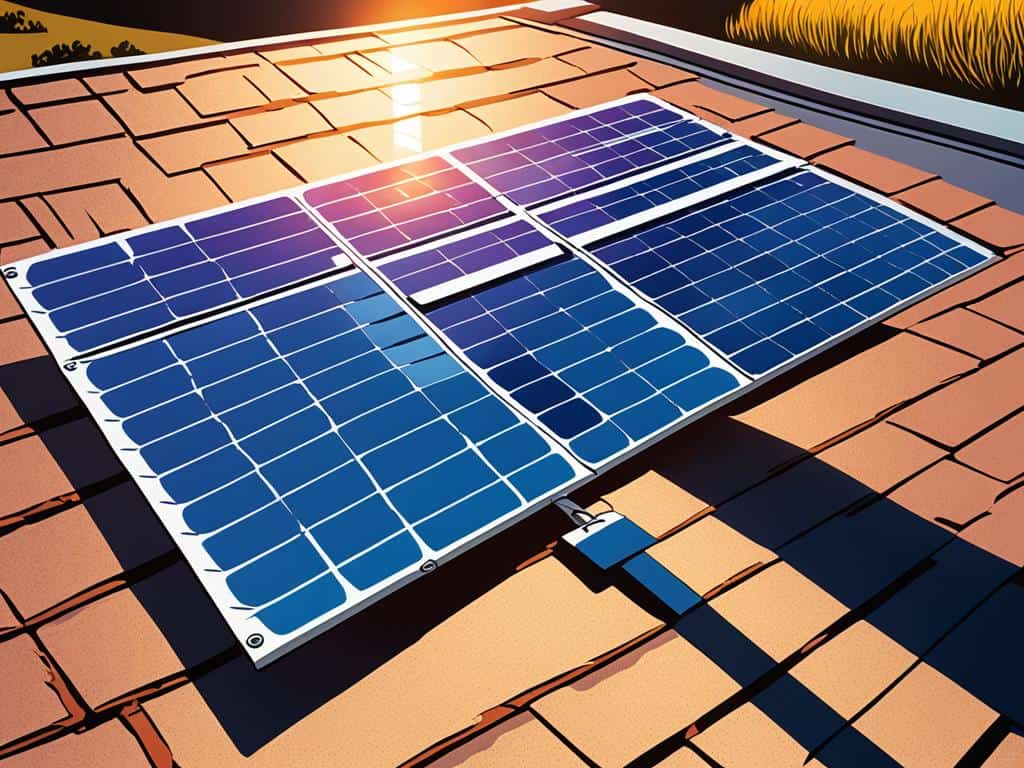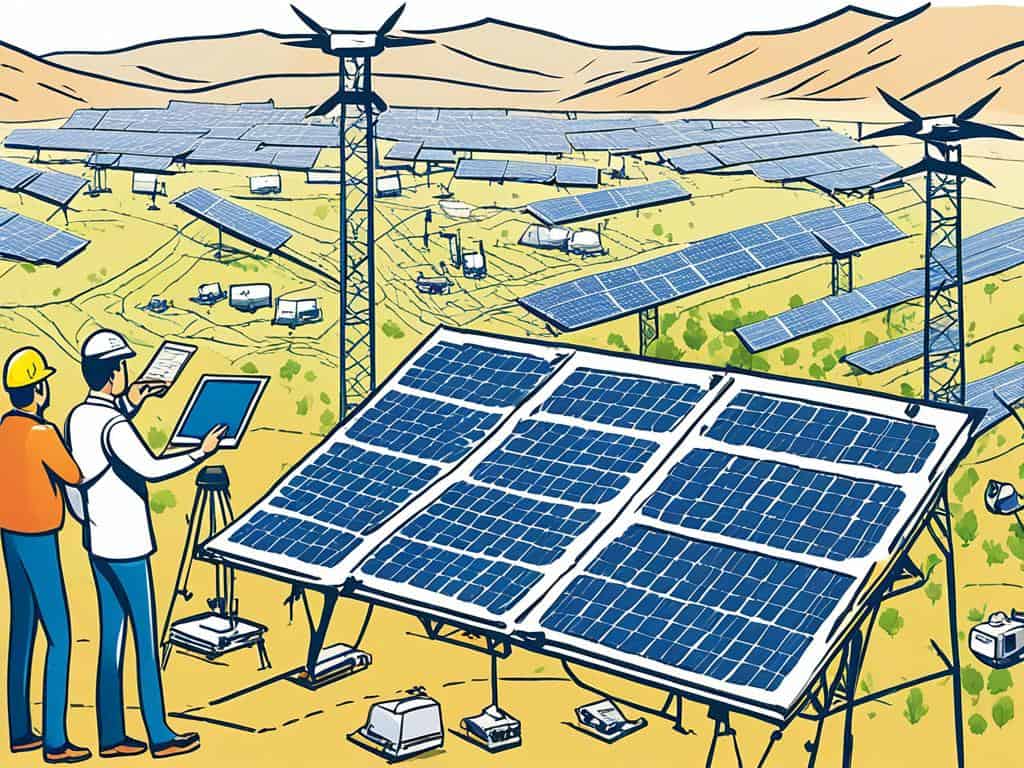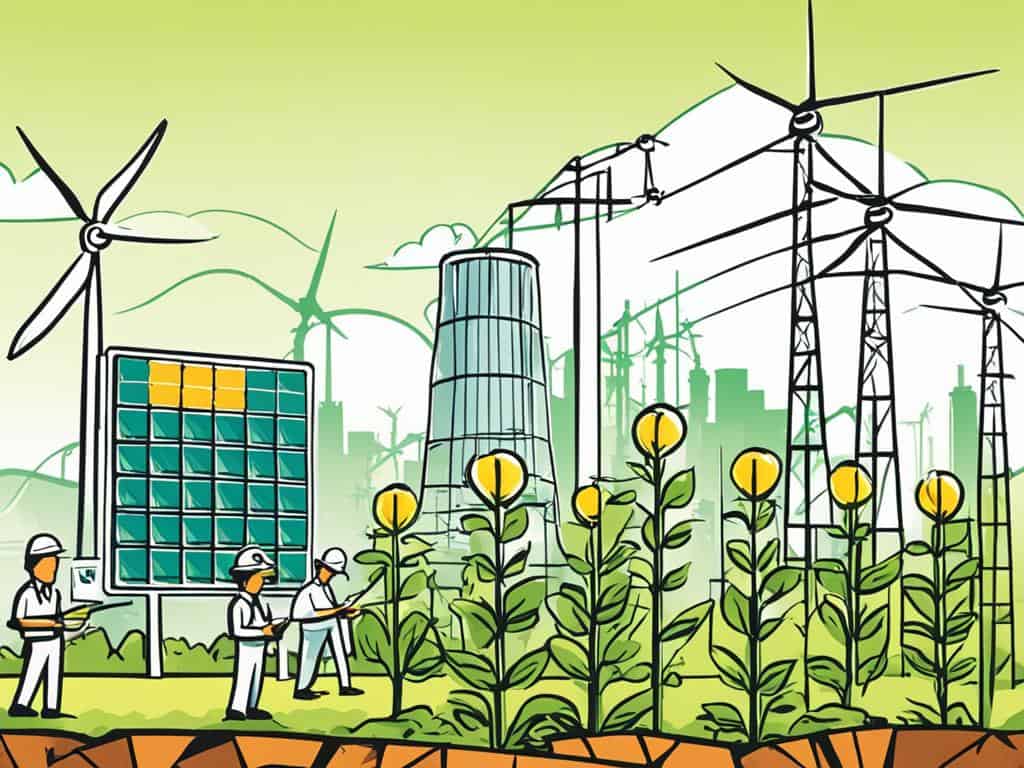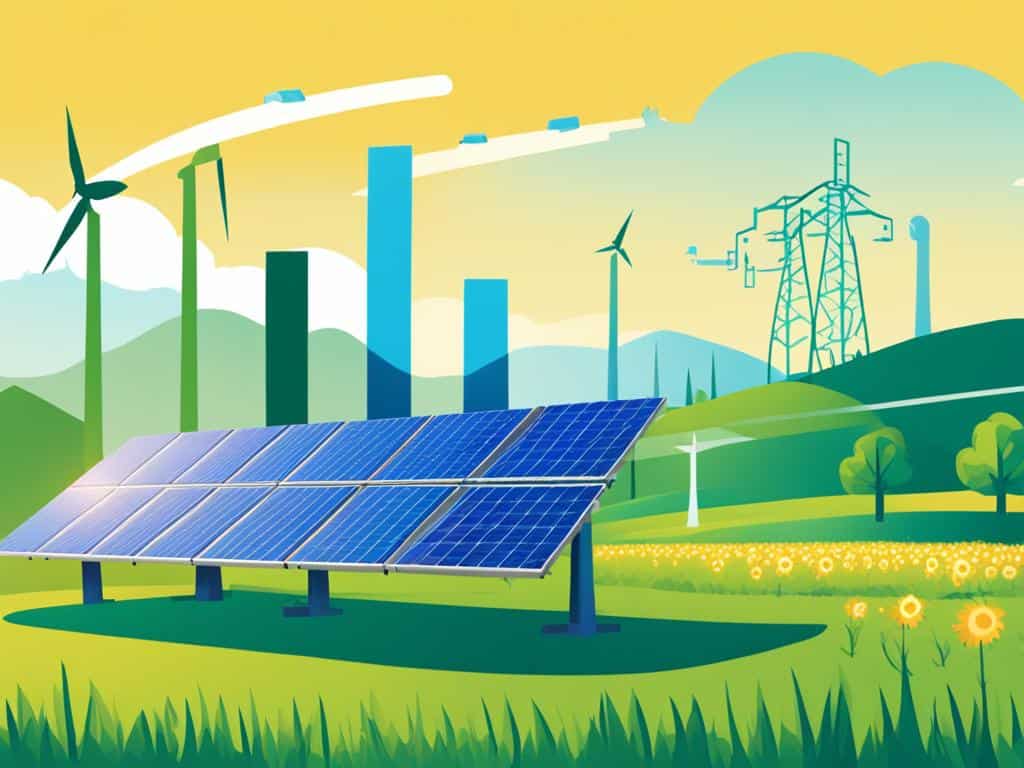Navigating Costs: Understanding the Expenses of 1 MW Solar Plants in India
Explore the financial landscape of a 1 MW solar power plant cost in India, including installation expenses and operational insights.

The price of a solar power plant in India is more than a number. It shows India’s steps towards a green future. The country has lots of sunlight and needs lots of energy. So, it’s leading the way in using renewable energy. But, what makes up the cost of a solar plant? And how does Fenice Energy help in this green shift?
Looking closely at the costs of putting up a 1 MW solar plant shows many details. It’s not just about the parts like solar panels, inverters, and frames. There’s also the cost of land, hiring skilled contractors, and updating power grids. All these points show solar power as not just another choice. They mark a new era in India’s story of energy.
Key Takeaways
- In-depth insights into the components determining the solar power plant price in India, from hardware to human resource.
- Current trends in solar power plant financial analysis highlighting the transition to more cost-effective renewable energy sources.
- Understanding the capital needed in the installation and operation of a solar power plant helps in accurate investing.
- The economic implications of solar energy compared to traditional electricity generation within India’s context.
- The potential of renewable energy in leading the charge towards a low-carbon future with Fenice Energy’s expertise.
Introduction to 1 MW Solar Power Plant Costs
India is moving towards a greener future. It’s important to know the 1 MW solar power plant cost per watt if you’re investing in solar. The country has reached an amazing capacity of 81.813 GWAC of solar power by March 31, 2024. This shows India’s big potential in using solar energy. Knowing the cost of setting up a solar power plant in India helps in making smart choices.
From 2010–2019, India saw nearly US$20.7 billion in foreign investments in solar. This boosted solar projects nationwide. Fenice Energy has seen solar power grow a lot. In fiscal year 2023-24, the government wants 40 GW of solar and hybrid projects. This is a big step for renewable energy.
Many things impact the cost of starting a solar power plant. India has about 42 solar parks. These parks offer land and necessary infrastructure, cutting down on initial costs. Solar parks also make connecting to the grid easier. This greatly impacts the overall cost.
| State | Installed Capacity (MW) | Rooftop Solar Capacity (MW) | Key Solar Projects | Additional Capacity Planned (MW) |
|---|---|---|---|---|
| Gujarat | 7,806 | N/A | N/A | N/A |
| Andhra Pradesh | 4,257 | N/A | Kurnool Ultra Mega Solar Park | 10,050 |
| Delhi | 211 | Primarily industrial/commercial | N/A | N/A |
Delhi has 211 MW of rooftop solar as of June 30, 2022. This trend is mostly seen in the industrial and commercial sectors. It shows the importance of local energy solutions. Solar power is flexible and works in many different places.
The Ministry of New & Renewable Energy helps by offering financial aid. This lowers the cost for those developing projects. The solar park scheme plans for 37,990 MW capacity. This will greatly help India’s energy needs.
The initial cost of setting up a solar power plant in India might be high. But, the efforts from different states and support from the government make solar power a good option for the future. This will lead to a sustainable and affordable solar power industry in India.
The Integral Components of a 1 MW Solar Facility
The solar power landscape in India is rapidly growing. Costs have gone down as the tech gets better. Important to this growth are more efficient solar panels and easier access to key parts. These are needed to set up a 1 MW solar power plant. Let’s look at the main parts and costs for Indian businesses getting into solar.

Solar Photovoltaic Panels and Their Pricing
Solar photovoltaic panels are key for catching solar energy. They are a big part of the total cost in India. Panel types like monocrystalline and polycrystalline differ in price and efficiency. Thanks to better efficiency, early costs can lead to more energy and savings later. With more solar projects in India, good policies can make solar tech cheaper.
Mounting Structures for Panel Optimization
Mounting structures help solar panels get the most sunlight. They work for both ground and roof setups. They make sure panels get the right amount of sun. This is crucial in India, where weather and land vary a lot. So, these structures affect how much it costs to run a solar power plant.
Inverter Technology and Conversion Efficiency
Inverters are essential in solar power systems. They change DC power from panels into AC power for the grid and homes. How well inverters work affects the plant’s performance and lifespan. This also adds to the costs of running the plant.
Protective Equipment and Monitoring Systems
Monitoring and protective gear are key but often overlooked. They protect the plant and give important data. This data helps manage the plant better. As India sets bigger solar goals, these systems help plants run well and last long.
| Component | Role | Contribution to Cost | Significance |
|---|---|---|---|
| Solar PV Panels | Energy Capture | High | Efficiency critical for output |
| Mounting Structures | Panel Placement | Moderate | Optimizes energy yield |
| Inverters | DC to AC Conversion | Moderate-High | Reliability ensures continuous operation |
| Monitoring Systems | Performance Tracking | Moderate | Essential for proactive maintenance |
Fenice Energy aims to bring solar solutions to homes and industries. Understanding and improving these parts is key. With better panels, inverters, and mounting systems, Fenice is making solar a better option in India. Solar plant costs are getting more competitive here.
1 MW solar power plant cost in India
Starting a solar power project means understanding the money involved. For a 1 MW solar plant, many important financial points determine the overall cost. We look into these key factors like the price of land, costs for engineering, procurement, and construction (EPC), the quality of solar panels, and the operations setup in India.

Land Acquisition and Its Impact on Total Cost
Finding the right land is key for building a solar power plant. Investors need to think about the land’s location, how sunny it is, and if it’s close to needed infrastructure. Generally, a 1 MW plant needs 4-5 acres. Land cost can change a lot, affecting the total investment in the solar plant.
Cost Variation in Engineering, Procurement, and Construction (EPC)
The EPC stage involves labor, materials, and expertise. Costs here change based on the project’s size, new technology, and the cost of local labor and materials. Completing the project well requires careful engineering and good project management. Companies like Fenice Energy focus on being efficient and innovative.
Solar Panel Quality and Efficiency as Cost Determinants
Picking solar panels is vital because it affects the cost. This depends on the panel’s quality, how efficient it is, and the warranty. Costs also vary based on how many panels are needed to reach 1 MW at top efficiency.
Additional Operational Infrastructure Expenses
Setting up a solar plant is more than just putting up panels. It needs other equipment like transformers, switchgear, and gear for connecting to the power grid. The cost for these extra parts depends on how complex they are and connecting to the grid.
| Cost Factor | Details | Estimated Cost Impact |
|---|---|---|
| Land Acquisition | 4-5 acres, depends on region and infrastructure accessibility | Varies by location |
| EPC Costs | Engineering, labor, materials, project management | Subject to project complexity & technology |
| Solar Panel Quality | Brand, efficiency rating, warranty | High-quality panels may demand a premium |
| Operational Infrastructure | Transformers, switchgear, transmission lines | Dependent on grid distance & complexity |
Variability in Solar Power Plant Costs
India is moving towards a greener future. Analyzing the solar power plant cost variability is key. Many factors influence this journey towards affordable clean energy. A detailed financial analysis of solar projects is needed. Despite past volatility, costs are set to become more attractive. This is thanks to technological advances and larger scale production.
The falling cost of solar power in India stands out. Experts expect it to plunge to Rs 1.9 per unit by 2030. This trend is driven by newer technologies like tracking systems. These could push costs down to Rs 1.90 per kWh, marking a significant drop from today. This decrease is crucial to the financial outcome of solar projects.

Investments in India’s electricity generation are growing. Estimates show yearly investments might hit Rs 1.65-1.75 lakh crore. That’s way above rates from the last ten years. With more investments, we’ll likely see more solar power plants. This will also affect the cost variability of solar plants.
Wind energy costs are dropping alongside solar. By 2030, wind energy could cost between Rs 2.26 and Rs 2.58 per kWh. This depends on using capacity better and taller masts. Compared to new non-pithead coal at Rs 6.98 per kWh and pithead coal at Rs 4.85 per kWh, renewables show a strong cost advantage.
The price of solar plus storage solutions is expected to halve by 2030. Costs could go from Rs 13.6 to Rs 6.34 kWh. Stand-alone storage might drop from Rs 29.0 to Rs 11.9 kWh. Improved storage technology plays a big part in reducing costs. This makes solar plants more appealing.
By 2030, renewables could make up 30% of India’s energy generation. This might add up to 420 GW of power. Furthermore, zero-carbon technologies might form 45% of the power mix. This would cut grid emission factors by 25% from 2018. Such changes aim to meet major sustainability goals.
The importance of solar project financial analysis is growing. Bold forecasts like these could reshape the energy industry. The variability in solar power plant costs is something everyone interested needs to watch closely.
Financial Models and Investment Scenarios for Solar Plants
Picking the right financial model for a solar investment is key to success. Fenice Energy helps understand methods like CAPEX and OPEX solar investments. This is important for long-term solar plant ownership and for those looking into solar power purchase agreements.
Capital Expenditure (CAPEX) Model Overview
The CAPEX model requires a big upfront investment. It gives the investor ownership and all benefits. Investors control the solar plant and make changes based on energy needs.
Investors fully own the system and get subsidies, tax breaks, and depreciation perks with CAPEX.
Operational Expense (OPEX) or Power Purchase Agreement (PPA) Model
The OPEX or PPA model involves no upfront cost as an external party owns the solar assets. Investors, like companies, buy the power generated. This method lets companies use solar without big initial expenses.
OPEX offers lower monthly costs than grid power. It’s good for businesses that want stable electricity prices over time.
| Investment Model | Upfront Cost | Ownership | Long-Term Benefits | Typical Power Cost |
|---|---|---|---|---|
| CAPEX | High | Investor | Tax benefits, depreciation, autonomy | No monthly power cost (post-recovery) |
| OPEX/PPA | Low to None | Solar energy company | Fixed lower power rates, no maintenance concerns | Lower than grid tariffs |
Choosing between CAPEX and OPEX impacts financial outcomes and management of the solar plant. Fenice Energy offers expertise in both models. They help investors decide based on their energy needs and financial goals.
Conclusion
Solar power in India has grown fast, with foreign investments around ₹1.56 lakh crore ($20.7 billion) from 2010 to 2019. Fenice Energy supports this growth with top-quality clean energy. Looking ahead to 2023-24, India plans to start 40 GW of solar and hybrid projects. This shows how vital solar energy is to the country’s future.
India hit its solar goal of 20 GW before 2022, setting a path to achieve 100 GW by 2022. This includes rooftop solar projects. The push for solar power profitability is stronger with about 42 solar parks helping developers. It ties with the International Solar Alliance’s goal, making solar power a global focus. Fenice Energy is part of India’s push for a stronger energy grid, thanks to solar energy being much greater than the country’s fossil fuels.
But, solar PV is mostly in a few states, raising questions about grid strength. States like Rajasthan and Gujarat are leading in solar capacity. This rapid growth in solar prompts a look at solar power’s return on investment. Discussions are needed on policies and models affecting solar’s success. For Fenice Energy, embracing solar means finding profitable and sustainable paths forward.


